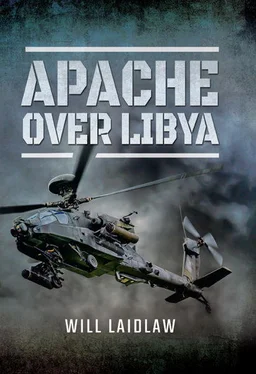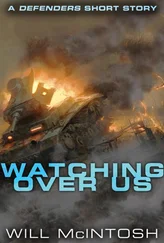As long as I did not make too much noise and incur the wrath of the ‘Afghanistan is the only war’ warriors I could quietly develop the maritime use of the Apache. During the summer of 2010, after my own pre-Afghanistan training in Arizona, I spent three weeks at sea gathering the facts and working out the range of our maritime potential. I needed to understand the unique challenges of conducting helicopter operations at sea, as well as exploring the limitations of putting an Apache on a ship. The immediate problems are obvious to a sailor, but not to a soldier. However big your ship, it will never be big enough. There is very little space. What space there is, is shared. The ship moves all the time – up, down, forwards, sideways. The power supply is different. You have to lash down anything that you want to stay on board, including helicopters. A mistake could mean a fire or a flood or a soul lost to the sea. You will knock your head, knees, hips and elbows on hatches and ladders. You share, a lot. It takes at least a week to know your way round a ship. Meals are measured in minutes. Inspections are frequent and standards are high. Discipline is strong. Sailors speak an entirely different language. Rapid assimilation to this environment is needed to get through the culture shock. Survivor’s Jackspeak is essential. If you’ve only done half a ‘dog watch’ or you are ‘Percy Pongo’, you had better learn quickly where to find your port and starboard oars and when it is acceptable to ‘double-duff’ in the Wardroom. More generally, knowing the difference between wanting a ‘goffer’ and getting ‘goffered’ is useful – ‘WAFUs’ are an easy target!
The sea is a ruthless place. It cares not for mistakes and it is a punisher. Throughout history, mariners have developed and refined procedures that ensure, as much as possible, the safety of a ship and her sailors. Transgression from these procedures could result in fire, flood or unscheduled bathing. The rule is simple: ‘the ship you are in is your best life-raft, do everything you can to preserve that.’ The challenge I would face in the coming months was how to convince the operators of such multi-layered safety structures to put in that life-raft an aircraft with a narrow undercarriage, high centre of gravity and tonnes of ammunition. Turning off all the lights and flying to and fro by night was a sound and workable idea that would increase capability rather than place it at risk. But first I had to get enough backing among colleagues in the Attack Helicopter Force to entertain such a low priority while the current conflict was in full swing.
Right at the top of the Force, support was there. The Force Commander was as excited as we were by the project, but many of his team and significant numbers of my experienced contemporaries were dedicated to Operation Herrick. Some were supportive, others less so. Whatever their opinion of our maritime enterprise, they had to drive hard to train and deploy squadrons to Afghanistan. Those who cared about the 656 activity acknowledged it might come in useful in the future; those who cared not made it clear. To the naysayers it was simple: we were at war in Afghanistan and must dedicate everything we did to that. To do anything else would be an act of disloyalty to our soldiers in Helmand. If your activity was in any way a distraction from someone else’s activity over there, you were doing the wrong thing. Those who feared the technical challenge also remarked that the Apache was a land helicopter and cannot stay upright on a moving, pitching flight deck at sea. It is not made from ‘marinized’ materials and will literally dissolve as the salt water corrodes it, they said. Additionally, there were concerns over the explosive content of rockets, missiles and 30mm ammunition in the magazine of the ship. The list of why it would not work was long; the challenge was massive.
The Apache was designed for land operations where take-off and landing both take place from a static location such as a field or a short runway. It has a high centre of gravity, due in part to its Fire Control Radar mounted above the main rotor blades, and a narrow undercarriage; these, combined, make it less stable on a pitching and rolling flight deck at sea. To illustrate the problem, take a look at a Sea King front-on and then compare it with an Apache. Someone in the design phase of the Sea King addressed the unstable platform issue by placing the undercarriage wide, and giving it a folding tail section so it can be stowed in tight spaces; they also gave it automatically ranging and folding rotor-blades, also handy for stowing and avoiding the need for engineers to laboriously do that work themselves. Now take a look at the Apache again. It has almost the same dimensions as the Sea King in length, width and height. However, it has none of the sea-going design features that the trusty workhorse of the Royal Navy and the Commando Helicopter Force has. Its tail is rigid, its undercarriage is narrow and its blades have to be folded and ranged by hand, taking a team of eight engineers over an hour to complete. By the end of our Mediterranean mission of 2011 this took just 25 minutes – but still five times longer than the Sea King!
There are a couple of other less than optimal aspects of the Apache for operations at sea which concentrate the minds of the aircrew inside. The aircraft has very poor ditching characteristics. In other words, it doesn’t float. The Apache sinks fast, so its occupants will quickly find themselves in a state of negative buoyancy. Once you are negatively buoyant you will sink, no matter what you do to swim upwards. The water pressure becomes too great for the life vest to inflate and the pilot, weighed down by ammunition, survival equipment and body armour, will sink at an increasing rate. We carry a short-term air supply bottle which gives perhaps thirty seconds to a minute of air – enough for another attempt at getting out of the cockpit, but no use if you are already too deep. Getting out in time is the top priority.
Being under water in a helicopter is a horrendous place to be, and many seaborne helicopters have quick mechanically jettisoning doors and floatation gear to assist aircrew should their aircraft have to land or crash into the sea. The Apache was designed to fly over land and take on tanks and well-armed troops. It is bristling with weapons and defensive systems and has no space or, until now, need for floatation aids. The other problem is that the canopy jettison is made from explosive detonation cord. No handy yellow and black lever to pull, whereupon the door falls away. The Apache canopy literally explodes when jettisoned. However, the jettison system has potentially lethal consequences if activated underwater. One of two things will happen. The external water pressure forces the blast debris back into the cockpit, which incapacitates the pilot. Or, if there is any water between the pilot and the canopy, the blast energy is transferred to the pilot, which is likely to be lethal. There is no way of winning once under water; the canopy has to be off before you go in.
For us maritime operators the second page of the Apache Emergency Flight Reference Cards is burned into the memory. It translates thus:
Get the canopy off before you enter the water, you won’t survive if you get this wrong. The water ingress will be violent. It will be dark, cold and you will be upside-down. Water will be up your nose and in your eyes and you will be disorientated. Get out fast. Make sure nothing is going to snag you on the way out. Fractions of seconds count.
We all spent time in the Under Water Escape Trainer, or ‘dunker’, to hone the procedures of escaping a ditched aircraft. A specially designed Apache module is used and aircrew wear the equipment they would be flying with to replicate the tight fit and tricky escape. Even with an emergency short-term air supply bottle to give an extra breath or two, egress, particularly from the front cockpit, is difficult. We all knew that an emergency ditching at night into the sea would lack the composure of the ‘dunker’.
Читать дальше












